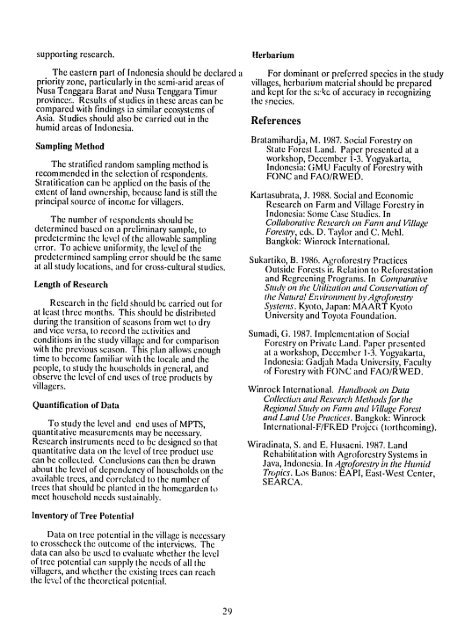multipurpose tree species research for small farms: strategies ... - part
multipurpose tree species research for small farms: strategies ... - part
multipurpose tree species research for small farms: strategies ... - part
Create successful ePaper yourself
Turn your PDF publications into a flip-book with our unique Google optimized e-Paper software.
supporting <strong>research</strong>.<br />
The eastern <strong>part</strong> of Indonesia should be declared a<br />
priority zone, <strong>part</strong>icularly in the semi-arid areas of<br />
Nusa Tenggara Barat and Nusa Tenggara Timur<br />
province. Results of studies in these areas can be<br />
compared with findings ia similar ecosystems of<br />
Asia. Studies should also be carried out in the<br />
humid areas of Indonesia.<br />
Sampling Method<br />
The stratified random sampling method is<br />
recommended in the selection of respondents.<br />
Stratification can be applied on the basis of the<br />
extent of land ownership, because land is still the<br />
principal source of income <strong>for</strong> villagers.<br />
The number of respondents should be<br />
determined based on a preliminary sample, to<br />
predetermine the level of the allowable sampling<br />
error. To achieve uni<strong>for</strong>mity, the level of the<br />
predetermined sampling error should be the same<br />
at all study locations, and <strong>for</strong> cross-cultural studies.<br />
Length of Research<br />
Research in the field should be carried out <strong>for</strong><br />
at least three months. This should be distributed<br />
during the transition of seasons from wet to dry<br />
and vice versa, to record the a:ctivities and<br />
conditions in the study village and <strong>for</strong> comparison<br />
with the previous season. This plan allows enough<br />
time to become familiar with the locale and the<br />
people, to study the households in general, and<br />
observe the level of end uses of <strong>tree</strong> products by<br />
villagers.<br />
Quantification of Data<br />
To study the level and end uses of MPTS,<br />
quantitative measurements may be necessary.<br />
Research instruments need to be designed so that<br />
quantitative data on the level of <strong>tree</strong> product use<br />
can be collected. Conclusions can then be drawn<br />
about the level of dependency of households on the<br />
available <strong>tree</strong>s, and correlated to the number of<br />
<strong>tree</strong>s that should be planted in the homcgarden to<br />
meet household needs sustainably.<br />
Inventory of Tree Potential<br />
Data on <strong>tree</strong> potential in the village is necessary<br />
to crosschcck the outcome of the interviews. The<br />
data can also be used to evaluate whether the level<br />
of <strong>tree</strong> potential can supply the needs of all the<br />
villagers, and whether the existing <strong>tree</strong>s can reach<br />
the level of the theoretical potential.<br />
29<br />
Herbarium<br />
For dominant or preferred <strong>species</strong> in the study<br />
villages, herbarium material should be prepared<br />
and kept <strong>for</strong> the srke of accuracy in recognizing<br />
the snecies.<br />
References<br />
Bratamihardja, M. 1987. Social Forestry on<br />
State Forest Land. Paper presented at a<br />
workshop, December 1-3. Yogyakarta,<br />
Indonesia: GMU Faculty of Forestry with<br />
FONC and FAO/RWED.<br />
Kartasubrata, J. 1988. Social and Economic<br />
Research on Farm and Village Forestry in<br />
Indonesia: Some Case Studies. In<br />
CollaborativeResearch on Fann and Village<br />
Foresty, eds. D. Taylor and C. Mehl.<br />
Bangkok: Winrock International.<br />
Sukartiko, B. 1986. Agro<strong>for</strong>estry Practices<br />
Outside Forests ir Relation to Re<strong>for</strong>estation<br />
and Rcgreening Programs. In Comparative<br />
Study on the Utilization and Consenationof<br />
the Vatura"Environment by Agro<strong>for</strong>estry<br />
Systems. Kyoto, Japan: MAART Kyoto<br />
University and Toyota Foundation.<br />
Sumadi, G. 1987. Implementation of Social<br />
Forestry on Private Land. Paper presented<br />
at a workshop, December 1-3. Yoyakarta,<br />
Indonesia: Gadjah Mada University, Faculty<br />
of Forestry with FONC and FAO/RWED.<br />
Winrock International. Handbook on Data<br />
Collectii and Research Methods <strong>for</strong> the<br />
RegionalStudy on Fan atnd 1llageForest<br />
and Land Use Practices. Bangkok: Winrock<br />
Intcrnational-F/FRED Projeci (Iorthcoming).<br />
Wiradinata, S. and E. Husaeni. 1987. Land<br />
Rehabilitation with Agro<strong>for</strong>estry Systems in<br />
Java, Indonesia. In Agro<strong>for</strong>estryin the Humid<br />
Tropics. Los Banos: EAPI, East-West Center,<br />
SEARCA.

















